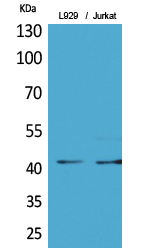E2F-4 (Acetyl Lys96) Polyclonal Antibody
- Catalog No.:YK0025
- Applications:WB;ELISA
- Reactivity:Human;Mouse;Rat
- Target:
- E2F-4
- Fields:
- >>Cell cycle;>>Cellular senescence;>>TGF-beta signaling pathway
- Gene Name:
- E2F4
- Protein Name:
- Transcription factor E2F4
- Human Gene Id:
- 1874
- Human Swiss Prot No:
- Q16254
- Mouse Gene Id:
- 104394
- Mouse Swiss Prot No:
- Q8R0K9
- Immunogen:
- The antiserum was produced against synthesized Acetyl-peptide derived from human E2F4 around the Acetylation site of Lys96. AA range:61-110
- Specificity:
- Acetyl-E2F-4 (K96) Polyclonal Antibody detects endogenous levels of E2F-4 protein only when acetylated at K96.
- Formulation:
- Liquid in PBS containing 50% glycerol, 0.5% BSA and 0.02% sodium azide.
- Source:
- Polyclonal, Rabbit,IgG
- Dilution:
- WB 1:500 - 1:2000. ELISA: 1:20000. Not yet tested in other applications.
- Purification:
- The antibody was affinity-purified from rabbit antiserum by affinity-chromatography using epitope-specific immunogen.
- Concentration:
- 1 mg/ml
- Storage Stability:
- -15°C to -25°C/1 year(Do not lower than -25°C)
- Other Name:
- E2F4;Transcription factor E2F4;E2F-4
- Observed Band(KD):
- 43kD
- Background:
- The protein encoded by this gene is a member of the E2F family of transcription factors. The E2F family plays a crucial role in the control of cell cycle and action of tumor suppressor proteins and is also a target of the transforming proteins of small DNA tumor viruses. The E2F proteins contain several evolutionally conserved domains found in most members of the family. These domains include a DNA binding domain, a dimerization domain which determines interaction with the differentiation regulated transcription factor proteins (DP), a transactivation domain enriched in acidic amino acids, and a tumor suppressor protein association domain which is embedded within the transactivation domain. This protein binds to all three of the tumor suppressor proteins pRB, p107 and p130, but with higher affinity to the last two. It plays an important role in the suppression of proliferation-associated ge
- Function:
- developmental stage:Present in the growth-arrested state, its abundance does not change significantly as cells move into and through the cell cycle.,function:Transcription activator that binds DNA cooperatively with DP proteins through the E2 recognition site, 5'-TTTC[CG]CGC-3' found in the promoter region of a number of genes whose products are involved in cell cycle regulation or in DNA replication. The DRTF1/E2F complex functions in the control of cell-cycle progression from G1 to S phase. E2F-4 binds with high affinity to RBL1 and RBL2. In some instances, can also bind RB protein.,polymorphism:The poly-Ser region of E2F4 is polymorphic and the number of Ser varies in the population (from 8 to 17). The variation might be associated with tumorigenesis.,PTM:Differentially phosphorylated in vivo.,similarity:Belongs to the E2F/DP family.,subunit:Component of the DRTF1/E2F transcription fa
- Subcellular Location:
- Nucleus.
- Expression:
- Found in all tissue examined including heart, brain, placenta, lung, liver, skeletal muscle, kidney and pancreas.
- June 19-2018
- WESTERN IMMUNOBLOTTING PROTOCOL
- June 19-2018
- IMMUNOHISTOCHEMISTRY-PARAFFIN PROTOCOL
- June 19-2018
- IMMUNOFLUORESCENCE PROTOCOL
- September 08-2020
- FLOW-CYTOMEYRT-PROTOCOL
- May 20-2022
- Cell-Based ELISA│解您多样本WB检测之困扰
- July 13-2018
- CELL-BASED-ELISA-PROTOCOL-FOR-ACETYL-PROTEIN
- July 13-2018
- CELL-BASED-ELISA-PROTOCOL-FOR-PHOSPHO-PROTEIN
- July 13-2018
- Antibody-FAQs
- Products Images

- Western Blot analysis of L929, Jurkat cells using Acetyl-E2F-4 (K96) Polyclonal Antibody. Secondary antibody(catalog#:RS0002) was diluted at 1:20000
.jpg)
- Western Blot analysis of L929 cells using Acetyl-E2F-4 (K96) Polyclonal Antibody. Secondary antibody(catalog#:RS0002) was diluted at 1:20000

- Western blot analysis of lysate from L929 cells, using E2F4 (Acetyl-Lys96) Antibody.



